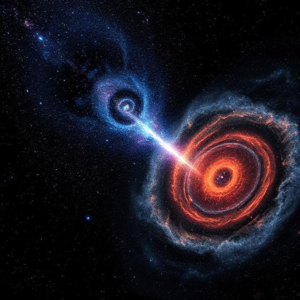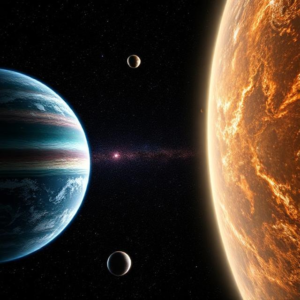Understanding the Cosmological Principle, Pulsars, Neutron Stars, and Galaxy Formation
The universe is full of fascinating objects and concepts that shape the cosmos. Among them, the Cosmological Principle, pulsars, neutron stars, and galaxy formation are key ideas in understanding how everything fits together in space. Let’s explore these topics in a simple way

1. The Cosmological Principle: The Universe is the Same Everywhere
The Cosmological Principle is a fundamental idea in cosmology (the study of the universe). It suggests that, on a large scale, the universe is homogeneous and isotropic.
What Does This Mean?
- Homogeneous means that the universe looks the same in every direction, and matter (like galaxies) is spread out evenly.
- Isotropic means that if you look in any direction, the universe will look roughly the same, with no particular point being special or different from others.
Why is the Cosmological Principle Important?
- This principle is the foundation of many theories in cosmology. It assumes that the laws of physics are the same everywhere in the universe, so scientists can study the cosmos as a whole.
- It helped lead to the Big Bang Theory and our understanding that the universe is expanding from a single point of origin.
- It also means that Earth, despite being our home, isn’t in any special position in the universe. The universe looks similar no matter where you are, whether on Earth or in a distant galaxy!
2. Pulsars and Neutron Stars: The Death of Massive Stars
When a massive star (at least 8 times the mass of the Sun) reaches the end of its life, it undergoes a dramatic transformation into either a neutron star or, in the case of even more massive stars, a black hole. One of the most fascinating features of neutron stars is their ability to emit pulses of radiation, creating objects called pulsars.
What is a Neutron Star?
- A neutron star is an incredibly dense remnant of a massive star that has exploded in a supernova. After the explosion, the core of the star collapses so much that the protons and electrons combine to form neutrons.
- Neutron stars are incredibly small, only about 20 kilometers (12 miles) across, but they are extremely dense. One teaspoon of a neutron star’s material would weigh about 6 billion tons on Earth!
What is a Pulsar?
- A pulsar is a rotating neutron star that emits beams of radiation, including radio waves, X-rays, or visible light, along its magnetic poles.
- The radiation is not constant; it pulses in regular intervals as the neutron star spins, much like a lighthouse beam, and that’s why they are called pulsars.
- These pulses can be detected on Earth, and their precise timing has allowed scientists to measure things like the speed of rotation of stars and study space in ways we never could before.
Why Are Pulsars Important?
- Pulsars are incredibly useful for studying the universe. Since their pulses are so regular, they can act as cosmic clocks that help measure time and distance across space.
- They also help us study extreme physics, such as the behavior of matter under incredibly high pressure and gravity, which can’t be replicated in labs on Earth.
3. Galaxy Formation: How Galaxies Came to Be
A galaxy is a massive collection of stars, gas, dust, and dark matter, all bound together by gravity. Our home galaxy is the Milky Way, but there are billions of other galaxies in the universe, each with its own unique structure.
How Do Galaxies Form?
- Big Bang and Early Universe: After the Big Bang, the universe was full of gas, mostly hydrogen and helium. Over time, this gas began to clump together under the force of gravity. These clumps grew larger and eventually formed the first galaxies.
- Gravity’s Role: As gravity pulled matter together, it created the dense centers of galaxies, where the first stars began to form. These stars grouped together to form galaxies.
- Merging of Galaxies: Galaxies can grow over time by merging with smaller galaxies. When galaxies collide, their stars can be affected by the strong gravity, leading to the formation of new stars and other phenomena.
Types of Galaxies
There are several types of galaxies, but the three main ones are:
- Spiral Galaxies:
- These have a central bulge surrounded by a flat disk with spiral arms. The Milky Way is a spiral galaxy.
- Elliptical Galaxies:
- These are round or oval-shaped galaxies with older stars and little gas. They don’t have spiral arms and look more uniform.
- Irregular Galaxies:
- These don’t have a clear shape. They may have been disturbed by gravity, such as from a collision with another galaxy.
Why Do Galaxies Matter?
- Galaxies are the building blocks of the universe. They contain everything we can see: stars, planets, and other objects. Studying them helps us understand how the universe evolved.
- Galaxy clusters, groups of galaxies held together by gravity, are some of the largest structures in the universe. Understanding how galaxies form and evolve gives us insight into the history and future of the cosmos.
4. Summary:
- Cosmological Principle: The idea that the universe is the same everywhere on a large scale, with matter distributed evenly, and the laws of physics are the same throughout space. It also tells us that Earth isn’t in a special or central position in the universe.
- Pulsars and Neutron Stars:
- Neutron stars are dense remnants of massive stars that collapsed after a supernova. They are incredibly small but incredibly dense.
- Pulsars are neutron stars that emit regular pulses of radiation as they rotate, which can be used as cosmic clocks to study the universe.
- Galaxy Formation: Galaxies form from gas clumping together under gravity, starting in the early universe after the Big Bang. Over time, galaxies can merge and grow. There are different types of galaxies—spiral, elliptical, and irregular—and they are the key structures that make up the universe.
These concepts—the Cosmological Principle, pulsars, neutron stars, and galaxy formation—are essential to understanding the structure and history of the universe. From the way galaxies evolve to the extreme physics of pulsars and neutron stars, these phenomena help reveal the mysteries of space











